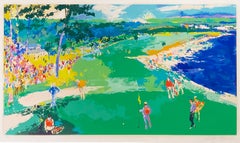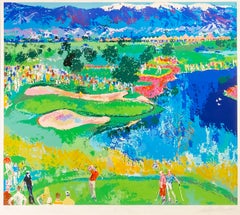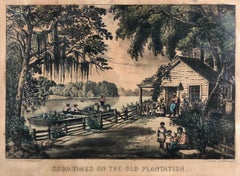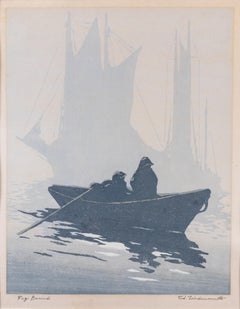Video Loading
Want more images or videos?
Request additional images or videos from the seller
1 of 12
Bataille de Fleurs (Carnaval of Flowers) from Nice and the Côte d’Azur1967
1967
$55,000List Price
About the Item
- Creation Year:1967
- Dimensions:Height: 34 in (86.36 cm)Width: 27 in (68.58 cm)
- Medium:
- Movement & Style:
- After:Marc Chagall (1887 - 1985, French)
- Period:
- Condition:
- Gallery Location:Missouri, MO
- Reference Number:1stDibs: LU747314453092
About the Seller
5.0
Vetted Professional Seller
Every seller passes strict standards for authenticity and reliability
Established in 1970
1stDibs seller since 2017
156 sales on 1stDibs
Typical response time: Several days
Authenticity Guarantee
In the unlikely event there’s an issue with an item’s authenticity, contact us within 1 year for a full refund. DetailsMoney-Back Guarantee
If your item is not as described, is damaged in transit, or does not arrive, contact us within 7 days for a full refund. Details24-Hour Cancellation
You have a 24-hour grace period in which to reconsider your purchase, with no questions asked.Vetted Professional Sellers
Our world-class sellers must adhere to strict standards for service and quality, maintaining the integrity of our listings.Price-Match Guarantee
If you find that a seller listed the same item for a lower price elsewhere, we’ll match it.Trusted Global Delivery
Our best-in-class carrier network provides specialized shipping options worldwide, including custom delivery.You May Also Like
Marc Chagall - Bateau Mouche au bouquet - Original Lithograph
By Marc Chagall
Located in Collonge Bellerive, Geneve, CH
Marc Chagall
Original Lithograph
Title: Bateau Mouche au bouquet
1963
Dimensions: 39 x 30 cm
Edition: 180
Unsigned as issued.
From Regards sur Paris
Published by André Sauret
Condit...
Category
1960s Modern Figurative Prints
Materials
Lithograph
$2,363
H 15.36 in W 11.82 in D 0.04 in
Marc Chagall - The Bible - Ruth at the feet of Boaz - Original Lithograph
By Marc Chagall
Located in Collonge Bellerive, Geneve, CH
Marc Chagall, Original Lithograh depicting an instant of the Bible.
Technique: Original lithograph in colours (Mourlot no. 234)
On the reverse: another black and white original litho...
Category
1960s Modern Figurative Prints
Materials
Lithograph
$1,063
H 13.98 in W 10.24 in D 0.04 in
Marc Chagall - The Bible - David saved by Michal - from VERVE
By Marc Chagall
Located in Collonge Bellerive, Geneve, CH
Marc Chagall, Lithograph from Verve depicting an instant of the Bible.
Technique: Lithograph in colours (Mourlot no. 234)
On the reverse: another black and white original lithograph ...
Category
1960s Modern Figurative Prints
Materials
Lithograph
$2,599
H 13.98 in W 10.24 in D 0.04 in
Original Cruise with S.S. Oceanic to the Bahamas - Caribbean travel poster
Located in Spokane, WA
Original cruise with S.S. Oceanic to the Bahamas and the Caribbean (original travel poster). This image features the original stamp from the travel agency on the right side. Linen-ba...
Category
1960s American Modern Landscape Prints
Materials
Lithograph
$750
H 32 in W 21.25 in D 0.3 in
Original Ireland Pictorial Vintage Poster Travel Map linen backed
Located in Spokane, WA
Original Ireland Pictorial Map, archival linen-backed, Grade A, ready to frame. This poster has no restoration, vibrant colors, and numerous details. Browne and Nolan Limited printed...
Category
1970s American Modern Landscape Prints
Materials
Lithograph
$740
H 33.5 in W 24.5 in D 0.3 in
Original 'Help RCA help USA, You and I Beat the Promise" vintage WWII poster
Located in Spokane, WA
‘Help RCA Help USA, Beat the Promise, You and I Beat the Promise,’ original WWII antique vintage military poster. In the foreground are two clasped hand...
Category
1940s American Modern Figurative Prints
Materials
Lithograph
$300 Sale Price
20% Off
H 22 in W 18 in D 0.05 in
Original Karting (Go-kart) vintage French racing poster
Located in Spokane, WA
Original French poster. Linen-backed KARTING HAFA motor oil KARTING poster estimated to be in the late 1950s—early 60s. It is in excellent condition and ready to frame.
COUPE d´ E...
Category
1950s American Modern Figurative Prints
Materials
Lithograph
$325
H 23 in W 15.25 in D 0.3 in
Original "Ring It Again, Third Liberty Loan vintage WW1 poster
Located in Spokane, WA
Original poster: Ring it Again Third Liberty Loan. Buy U. S. Gov't Bonds. World War 1 lithograph poster over 100 years old. It is mounted on acid-free archival linen. It looks l...
Category
1920s American Modern Figurative Prints
Materials
Lithograph
$500 Sale Price
20% Off
H 30 in W 20 in D 0.05 in
Is that Gun Loaded? NRA original vintage gun safety poster
Located in Spokane, WA
Original “Is that Gun LOADED?” vintage National Rifle Association of America vintage poster. Archival linen backed in excellent condition, mint, and ready to frame. Printed in 1946 on a thick cardboard stock. Excellent condition, vibrant green and reds. 22 x 14 inches. NO paper loss, no tears. These are images of the exact poster you will receive.
The poster shows a careless man incorrectly holding a rifle pointing towards another person. The men’s camping gear...
Category
1940s American Modern Landscape Prints
Materials
Lithograph
Original 'Be Sure of Your Backstop' vintage N. R. A., 1946 Gun Safety poster
Located in Spokane, WA
Original “Be Sure of Your Backstop” vintage National Rifle Association of America vintage poster. Printed in 1946 on a thick cardboard stock. Gppd condition with slight wear and...
Category
1940s American Modern Landscape Prints
Materials
Lithograph
$398
H 22 in W 12 in D 0.05 in
More From This Seller
View AllThe 18th at Pebble Beach
By LeRoy Neiman
Located in Missouri, MO
The 18th at Pebble Beach
Leroy Neiman (American, 1921-2012)
Signed in pencil lower right
Edition 176/400 lower left
26 x 43 inches
37.25 x 54.5 inches with frame
Known for his bright, colorful paintings and screen prints of famous sports stars...
Category
20th Century American Modern Landscape Prints
Materials
Color, Lithograph
Cove at Vintage
By LeRoy Neiman
Located in Missouri, MO
Cove at Vintage
Leroy Neiman (American, 1921-2012)
Signed in pencil lower right
Edition 237/375 lower left
34 x 36.5 inches
43 x 45.5 inches with frame
Known for his bright, colorful paintings and screen prints of famous sports stars...
Category
20th Century American Modern Landscape Prints
Materials
Color, Lithograph
Good Times on the Old Plantation
By Currier & Ives
Located in Missouri, MO
Currier & Ives (Publishers)
"Good times on the Old Plantation" 1872
Handcolored Lithograph
Size Height 10 in.; Width 13.9 in.
Framed Size: approx 16 x 19.5
Category
1870s Victorian Figurative Prints
Materials
Lithograph
Fog Bound
By Tod Lindenmuth
Located in Missouri, MO
Fog Bound
Tod Lindenmuth (American, 1885-1976)
Woodblock Print
14 x 11 inches
26 x 20.25 inches with frame
Signed Lower Right
Titled Lower Left
A founder of the Provincetown Art Association and one of the original Provincetown Printers, Tod Lindenmuth was a semi-abstract painter and graphic artist who did much to promote modernist styles. Although he was much influenced by Abstract Expressionism, his subject matter was realistic enough to be recognizable. He did linoleum cuts and was one of the first to work with that medium, and towards the end of his life, he experimented with collage. In the 1930s, he had commissions for the Public Works of Art Project and the Works Progress Administration.
Lindenmuth was born in Allentown, Pennsylvania. He studied with Robert Henri at the New York School of Art in Manhattan, and in Provincetown with E. Ambrose Webster and George Elmer Browne.
He first exhibited in Provincetown in 1915, and between 1917 and 1928 served on the jury for the Provincetown Art Association's 'First Modernistic Exhibition". He exhibited regularly with the Society of Independent Artists in New York.
He married artist and illustrator Elizabeth Boardman Warren...
Category
Mid-20th Century American Modern Figurative Prints
Materials
Color
$3,000
Sailboat and Gull
Located in Missouri, MO
Sailboat and Gull
Ferol K. Sibley Warthen (American, 1890-1986)
Color Woodblock Print
Edition 31/31
7 x 7 inches
14 x 14 inches with frame
Signed Lower Right
Titled and Numbered Lower Left
Born 1890, Died 1986...
Category
Mid-20th Century American Modern Figurative Prints
Materials
Color
Alongside
By Tod Lindenmuth
Located in Missouri, MO
Alongside, 1941
Tod Lindenmuth (American, 1885-1976)
Color Woodblock Print
9 x 7 inches
19.75 x 14.5 inches with frame
Signed Lower Right
Titled and Dated Lower Left
A founder of the Provincetown Art Association and one of the original Provincetown Printers, Tod Lindenmuth was a semi-abstract painter and graphic artist who did much to promote modernist styles. Although he was much influenced by Abstract Expressionism, his subject matter was realistic enough to be recognizable. He did linoleum cuts and was one of the first to work with that medium, and towards the end of his life, he experimented with collage. In the 1930s, he had commissions for the Public Works of Art Project and the Works Progress Administration.
Lindenmuth was born in Allentown, Pennsylvania. He studied with Robert Henri at the New York School of Art in Manhattan, and in Provincetown with E. Ambrose Webster and George Elmer Browne.
He first exhibited in Provincetown in 1915, and between 1917 and 1928 served on the jury for the Provincetown Art Association's 'First Modernistic Exhibition". He exhibited regularly with the Society of Independent Artists in New York.
He married artist and illustrator Elizabeth Boardman Warren...
Category
1940s American Modern Figurative Prints
Materials
Color
Recently Viewed
View AllMore Ways To Browse
Wooden Wedges
Dior Ballet
Marc Chagall Cote Azur
Wolfgang Hutter
Woman In The Waves
Wynn Chamberlain
12 Tribes Of Israel
1930s Wpa Prints
1960s Womens Fashion
Alaska Watercolor
Albrecht Durer Woodcut Print
Alex Katz Dancer 2
Alice Neel Lithograph
Anders Zorn Etchings
Andy Warhol Dollar Sign
Andy Warhol Electric Chair Art
Antique Lawyer Prints
Arnold Friberg



